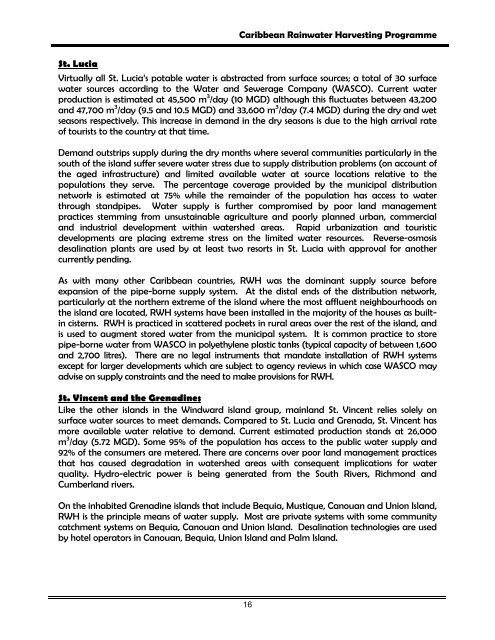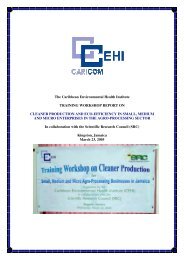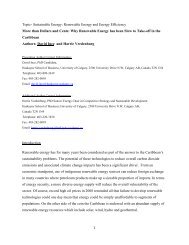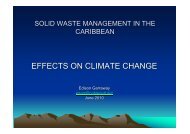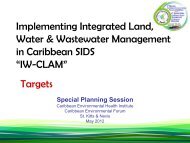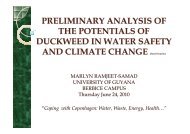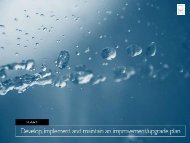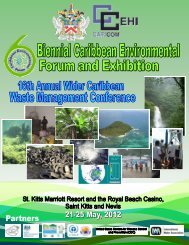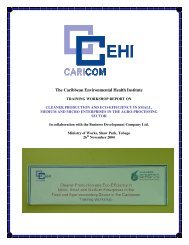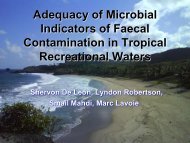A programme for Promoting Rainwater Harvesting in the Caribbean
A programme for Promoting Rainwater Harvesting in the Caribbean
A programme for Promoting Rainwater Harvesting in the Caribbean
You also want an ePaper? Increase the reach of your titles
YUMPU automatically turns print PDFs into web optimized ePapers that Google loves.
<strong>Caribbean</strong> <strong>Ra<strong>in</strong>water</strong> <strong>Harvest<strong>in</strong>g</strong> ProgrammeSt. LuciaVirtually all St. Lucia’s potable water is abstracted from surface sources; a total of 30 surfacewater sources accord<strong>in</strong>g to <strong>the</strong> Water and Sewerage Company (WASCO). Current waterproduction is estimated at 45,500 m 3 /day (10 MGD) although this fluctuates between 43,200and 47,700 m 3 /day (9.5 and 10.5 MGD) and 33,600 m 3 /day (7.4 MGD) dur<strong>in</strong>g <strong>the</strong> dry and wetseasons respectively. This <strong>in</strong>crease <strong>in</strong> demand <strong>in</strong> <strong>the</strong> dry seasons is due to <strong>the</strong> high arrival rateof tourists to <strong>the</strong> country at that time.Demand outstrips supply dur<strong>in</strong>g <strong>the</strong> dry months where several communities particularly <strong>in</strong> <strong>the</strong>south of <strong>the</strong> island suffer severe water stress due to supply distribution problems (on account of<strong>the</strong> aged <strong>in</strong>frastructure) and limited available water at source locations relative to <strong>the</strong>populations <strong>the</strong>y serve. The percentage coverage provided by <strong>the</strong> municipal distributionnetwork is estimated at 75% while <strong>the</strong> rema<strong>in</strong>der of <strong>the</strong> population has access to waterthrough standpipes. Water supply is fur<strong>the</strong>r compromised by poor land managementpractices stemm<strong>in</strong>g from unsusta<strong>in</strong>able agriculture and poorly planned urban, commercialand <strong>in</strong>dustrial development with<strong>in</strong> watershed areas. Rapid urbanization and touristicdevelopments are plac<strong>in</strong>g extreme stress on <strong>the</strong> limited water resources. Reverse-osmosisdesal<strong>in</strong>ation plants are used by at least two resorts <strong>in</strong> St. Lucia with approval <strong>for</strong> ano<strong>the</strong>rcurrently pend<strong>in</strong>g.As with many o<strong>the</strong>r <strong>Caribbean</strong> countries, RWH was <strong>the</strong> dom<strong>in</strong>ant supply source be<strong>for</strong>eexpansion of <strong>the</strong> pipe-borne supply system. At <strong>the</strong> distal ends of <strong>the</strong> distribution network,particularly at <strong>the</strong> nor<strong>the</strong>rn extreme of <strong>the</strong> island where <strong>the</strong> most affluent neighbourhoods on<strong>the</strong> island are located, RWH systems have been <strong>in</strong>stalled <strong>in</strong> <strong>the</strong> majority of <strong>the</strong> houses as built<strong>in</strong>cisterns. RWH is practiced <strong>in</strong> scattered pockets <strong>in</strong> rural areas over <strong>the</strong> rest of <strong>the</strong> island, andis used to augment stored water from <strong>the</strong> municipal system. It is common practice to storepipe-borne water from WASCO <strong>in</strong> polyethylene plastic tanks (typical capacity of between 1,600and 2,700 litres). There are no legal <strong>in</strong>struments that mandate <strong>in</strong>stallation of RWH systemsexcept <strong>for</strong> larger developments which are subject to agency reviews <strong>in</strong> which case WASCO mayadvise on supply constra<strong>in</strong>ts and <strong>the</strong> need to make provisions <strong>for</strong> RWH.St. V<strong>in</strong>cent and <strong>the</strong> Grenad<strong>in</strong>esLike <strong>the</strong> o<strong>the</strong>r islands <strong>in</strong> <strong>the</strong> W<strong>in</strong>dward island group, ma<strong>in</strong>land St. V<strong>in</strong>cent relies solely onsurface water sources to meet demands. Compared to St. Lucia and Grenada, St. V<strong>in</strong>cent hasmore available water relative to demand. Current estimated production stands at 26,000m 3 /day (5.72 MGD). Some 95% of <strong>the</strong> population has access to <strong>the</strong> public water supply and92% of <strong>the</strong> consumers are metered. There are concerns over poor land management practicesthat has caused degradation <strong>in</strong> watershed areas with consequent implications <strong>for</strong> waterquality. Hydro-electric power is be<strong>in</strong>g generated from <strong>the</strong> South Rivers, Richmond andCumberland rivers.On <strong>the</strong> <strong>in</strong>habited Grenad<strong>in</strong>e islands that <strong>in</strong>clude Bequia, Mustique, Canouan and Union Island,RWH is <strong>the</strong> pr<strong>in</strong>ciple means of water supply. Most are private systems with some communitycatchment systems on Bequia, Canouan and Union Island. Desal<strong>in</strong>ation technologies are usedby hotel operators <strong>in</strong> Canouan, Bequia, Union Island and Palm Island.16


